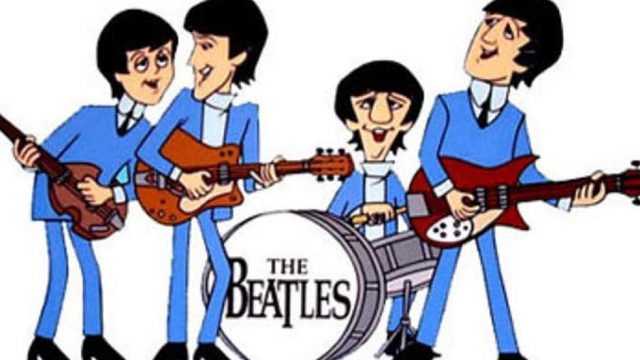I am old enough to have watched Fat Albert and the Cosby Kids in its original airing. Not the first few seasons, I grant you, but I do remember watching it some as a kid. I’m too young for Jackson 5ive (and, yes, it was actually called that), but I remember seeing it on rerun now and again. And I forget how old I was at the time, but the Disney Channel went through a weird Beatles phase when I was a kid that included airing the old Beatles cartoon. And that’s just a start—there are a ton more cartoons that were made of pop culture figures without even getting into things like having Sonny and Cher or Davy Jones appear on Scooby-Doo.
I mean, I feel like animated pop culture figures have existed about as long as true animation, of course; one of these days, I’ll get to “The Autograph Hound,” a 1939 Donald Duck cartoon where he breaks onto a studio lot and harasses celebrities, for Disney Byways. And The Flintstones did it, too, especially with anyone they could get a rock pun out of. Hence “Stoney Curtis” and so forth. But a weirder phenomenon to me is just flat-out having animated versions of either real people or else characters from other media who they made cartoons out of that seldom had anything to do with the original version.
I’m not sure where this got started. Possibly with The Beatles, which debuted in 1965 and ran for three seasons; honestly, a cartoon was just one more aspect of Beatlemania. And I suppose it does also tie in with all those parodies on The Flintstones, some but not all of whom were voiced by the person being parodied. Now, obviously that wasn’t the case for the Beatles; Paul Frees was many things, including a fine singer, but George Harrison he was not. What’s interesting to me, in fact, is that the Jacksons did not voice themselves but Diana Ross voiced herself on the pilot.
And then you get into things like Gilligan’s Planet, wherein the various people you’ve come to know and know from Gilligan’s Island are now in space. And voiced by themselves, because let’s face it, you could easily get them. Likewise The Fonz and the Happy Days Gang, which involved a malfunctioning time machine; you’d think Ron Howard would’ve rather been off directing for Roger Corman or something in 1980, but there we are. And the animated Laverne and Shirley were in the army. Basically, if you had a cartoon version, it bore little resemblance to the live-action.
Possibly the most famous of these is Rambo: The Force of Freedom, because nothing says “fun Saturday morning entertainment for kiddies” like an R-rated feature about a Vietnam veteran dealing with PTSD and the failure of his country to provide proper support for its veterans, I guess. And of course they had to tone down the violence, because while the Wikipedia page talks about how it was inappropriate for kids, I’ve seen Rambo II, and that level of violence isn’t appropriate for anyone. Though it was already pretty cartoonish, I’ll admit. And I can’t help wondering if this was part of the downfall of the genre, because surely everyone could recognize from that point how ridiculous the whole thing was.
But the last of these I actually remember is Hammerman, from 1991. Where MC Hammer tried to solve social injustice with a pair of magical shoes, why not. Making it an interesting entry in the genre—on the one hand, we were clearly watching the show (if we were, which not many people did, I believe) for the pleasure of watching music phenomenon MC Hammer, but it involved the fantastical elements of “let’s make a cartoon out of a pre-existing TV show” that sent Gilligan into space and the Fonz traveling in time.
I guess we don’t have these as much these days because we have Twitter and YouTube and things, if we want to get to know more about our favourite celebrities. And while TV shows continue from movies—especially for Disney—that’s not entirely the same thing as I’m looking at, where animated TV shows continue from other TV shows. Coming next from Dick Wolf, Law & Order Babies?
Continue, please, to support your local protests; I got on this train of thought trying to think of black-character-led children’s shows I could access to show my kids.

